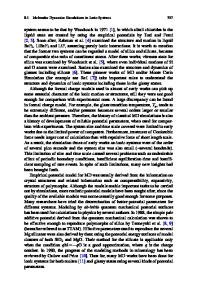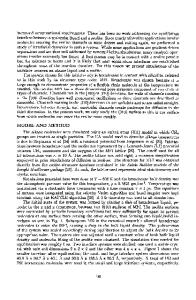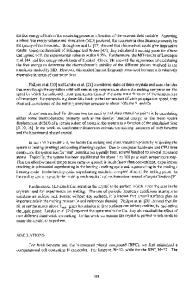Molecular Dynamics Simulations of Reactive Wetting
- PDF / 95,009 Bytes
- 6 Pages / 612 x 792 pts (letter) Page_size
- 77 Downloads / 389 Views
Molecular Dynamics Simulations of Reactive Wetting Edmund B. Webb III and Gary S. Grest Sandia National Laboratories, Albuquerque, NM 87185-1411, U.S.A. ABSTRACT The wetting and spreading of liquid Ag drops on Cu (001) surfaces are studied with molecular dynamics simulations. As the liquid Ag drop spreads on the Cu surface, reactive wetting occurs in that a Ag/Cu alloy is formed. The results for the reactive wetting case are compared to a frozen substrate for which there is no alloying. At the highest temperature studied, T = 1300 K, the radius of the drop spreads faster than for the frozen substrate, indicating the driving force for spreading is greater when the liquid and solid mix. Lowering temperature in reactive systems results in behavior more similar to non-reactive systems due to suppressed mixing. INTRODUCTION Wetting of a solid by a liquid is a phenomenon relevant to a wide range of technologies, including joining processes. When soldering or brazing two materials together, a filler metal (a solder or braze alloy) is used. Processing at elevated temperature melts the filler, which then coats the parts to be joined. Subsequent reactions occur between the liquid alloy and the materials, binding the parts together. Forming a strong mechanical bond requires the liquid to coat, or wet, the surface of the materials and poor wetting can result in a weak joint. For many materials, particularly metals, the solder or braze alloy not only wets the surface but reacts with the materials forming a reactive wetting layer. In some cases, the alloy may not even wet a material until a surface layer of reaction product forms between the alloy and material [1]. Metal joining is in many ways a mature technology, given the large body of relevant experimental data. Phase diagrams and equilibrium contact angles are available for many alloys. Much analysis has been aimed at evaluating dynamic spreading of reactive alloys. Standard mechanical tests have been established for solder or braze joints and these are often combined with post-processing analysis [2]. Nonetheless, fundamental driving forces in common metal systems are not clear because experiments lack the resolution to evaluate wetting and spreading at the necessary scale. For instance, it is still a matter of debate as to the presence and role of an atomic foot, or monolayer of atoms, which precedes the wetting front [1]. Such a feature could be the source of reaction product that permits further wetting. In general, a more fundamental understanding of reactive wetting would benefit joining technology. Modeling is an attractive method to further elucidate the important features of reactive wetting. Analytical models have been developed and used to examine kinetics such as the shape of the reaction zone as a function of time [3]. These permit investigation of physical phenomena controlling reactive wetting, such as diffusion versus reaction rates, but are unable to address what occurs at the atomistic scale. Atomistic modeling techniques, such as molecular dynamics (MD), a
Data Loading...











